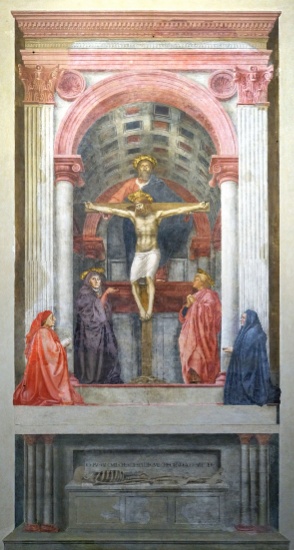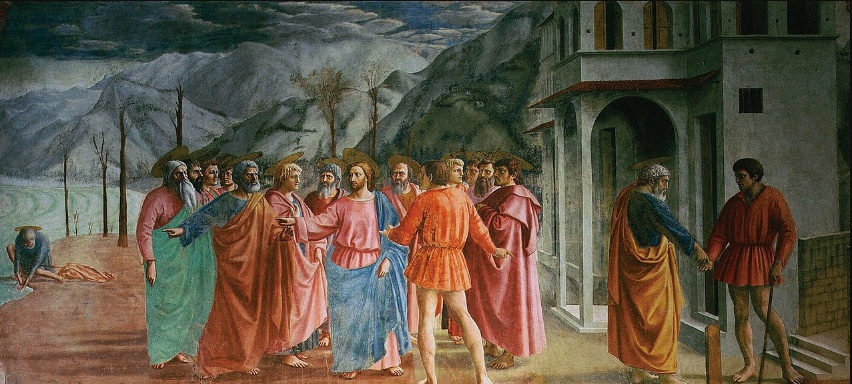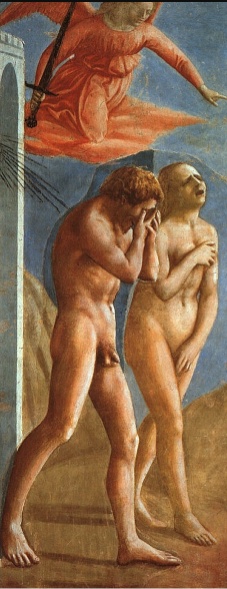The artistic revolution of the Renaissance was significantly shaped by the development of linear perspective by Filippo Brunelleschi, which was swiftly adopted by contemporary artists, most notably Masaccio (1401-1428). During his brief career, Masaccio left an indelible mark on art through his innovative use of perspective and chiaroscuro.

Masaccio's fresco, "The Holy Trinity" (1425-1428), created for a prominent Florentine family, is an early exemplar of linear perspective in painting. Located in the Santa Maria Novella church, this fresco is notable for its precise application of perspective to create an illusion of three-dimensional space on a flat surface. The foreground features a skeleton on a tomb with the inscription: "I was what you are, and what I am you shall be", a stark reminder of mortality. Above, the donors kneel at the entrance of a chapel, dressed in the vivid red robes of a gonfaloniere, the highest public office in the Republic. Inside the chapel, the Virgin Mary and St. John stand on either side of the crucifix, supported from behind by God the Father. Unlike medieval art, where donor figures were significantly smaller than the divine figures, here they are portrayed proportionally larger, more integral to the composition. This proportionality is achieved through Brunelleschi’s perspective technique, allowing all figures to be depicted accurately within a unified spatial setting. The lower tomb appears as an extension into the church, while the upper chapel seems to recess into the wall, showcasing Masaccio's mastery of spatial illusion.

Masaccio's application of light and shadow in "The Tribute Money" further exemplifies his innovative approach. The light source, seemingly from the chapel window, enhances the three-dimensionality and realism of the figures. This fresco narrates the story of Christ instructing Peter to find a coin in the mouth of a fish to pay the tax collector. Through the interplay of light and shadow, Masaccio imparts a profound sense of realism and spatial depth. The figures are arranged around Christ in a spacious landscape, contrasting with the flat, stage-like settings typical of Giotto's compositions. The single light source casts natural shadows and creates a dynamic interplay between illuminated and shaded areas, emphasizing the physical presence and weight of the figures.

Masaccio's ability to convey human emotion is strikingly evident in "The Expulsion from Eden", where Adam and Eve are depicted with palpable anguish and despair as they are banished from Paradise. Their expressions and body language vividly convey their sorrow and regret, capturing the viewer's empathy. This emotional depth is achieved through careful modulation of light and shadow, highlighting the figures' solid forms and their inner turmoil. The contrast with medieval art, which often lacked such emotional nuance, is stark, showcasing Masaccio's revolutionary approach to depicting human experience.
Throughout his short life, Masaccio created numerous significant works that laid the groundwork for Renaissance art. His innovative use of perspective and chiaroscuro provided invaluable lessons for later artists like Michelangelo and Raphael. Masaccio's paintings not only demonstrate technical excellence but also reflect a profound understanding of human emotion and spirituality, setting a new standard for Renaissance art. His integration of Brunelleschi's perspective system with his keen observation of human nature resulted in a body of work that continues to resonate.
Masaccio's legacy is encapsulated in his masterpieces like "The Holy Trinity", "The Tribute Money", and "The Expulsion from Eden". These works exemplify his pioneering use of perspective, his mastery of light and shadow, and his ability to convey deep human emotions. By redefining the depiction of space and emotion in painting, Masaccio established himself as one of the most important artists of the early Renaissance. His influence endures, inspiring countless artists through the centuries and continuing to captivate viewers with the timeless power of his art.